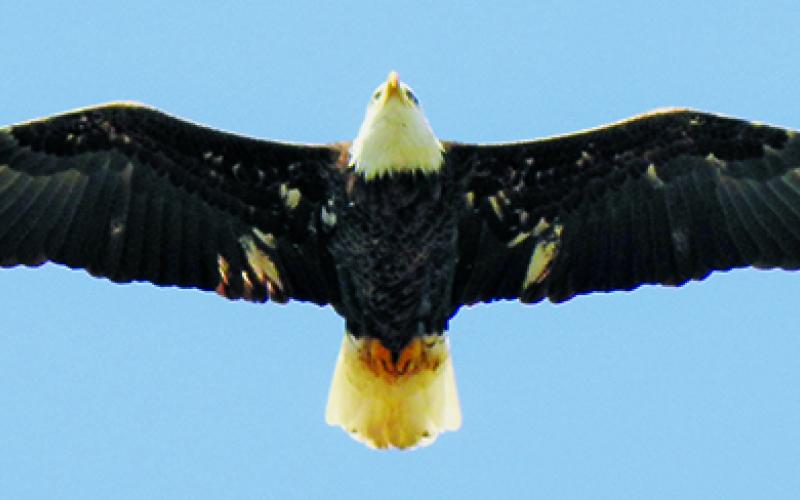Bald-eagle sightings becoming more frequent in state, Graham County
The most majestic of birds, the symbol of our nation, the most sacred bird in Cherokee culture – crouched by the side of the highway, choking down hunks of roadkill opossum – has prompted Graham County residents to wonder: is this normal?
Is the bald eagle population increasing? And is roadkill a usual item on the bald eagle menu?
The answer to all three questions is a definitive yes.
While bald eagles are primarily hunters and fishers, these top-of-the-food-chain predators are not above easy pickings. The Audubon Society cites stealing prey from other predators as a common bald eagle feeding tactic, but eating roadkill is even easier than stealing. Once an eagle discovers an easy source of food, the bird adapts, building a nest near a fish hatchery, checking hunting camps for discarded entrails or monitoring the pavement for roadkill.
Perhaps this is why Benjamin Franklin referred to the bald eagle as “a bird of bad moral character,” championing the turkey as a national symbol instead. Of course, Thomas Jefferson and John Adams prevailed and the bald eagle has been the symbol of our nation since 1782.
Though the birds have long been protected by both the Bald and Golden Eagle Protection Act as well as the Migratory Bird Treaty, 68 percent of bald eagle mortality is still caused by humans, whether by poisoning, gunshot, or collision with a vehicle.
For most of its history, the bald eagle saw little threat from humans. Native American tribes considered the birds sacred and harming them in any way was forbidden. However, European settlers considered eagles to be vermin. Before Europeans arrived in North America, the bald eagle population is estimated at near half a million birds, but after centuries of habitat loss and hunting, the numbers were already at a record low by the start of the 20th century.
When post-World War II use
of DDT became commonplace, National Geographic described the eagle population as going “from decline to free fall.” The bald eagle was added to the Endangered Species in 1967, as the birds’ numbers continued to plummet. An insecticide which remained in widespread use for three decades, DDT washed into streams and entered the food chain, weakening bald eagle eggshells and nearly bringing the species to extinction.
According to the U.S. Fish and Wildlife Service, by the 1960s, there were fewer than 400 nesting pairs in the lower 48.
Once Congress banned the general use of DDT in 1973, the bald eagle population rebounded immediately and today the eagles live in every state but Hawaii. An estimated 10,000 breeding pairs are currently active. Recovery has been so robust that the bald eagle was removed from the Endangered Species list in 2007.
The N.C. Bald Eagle Project began raising eagles in captivity in 1982 then introducing them to the wild. The project also monitored populations and nesting sites.
Today, there are more than 80 breeding pairs in the state, including one confirmed nesting site on
Fontana Lake and another suspected site near Tallulah Road in Robbinsville.
With an estimated nationwide population of 150,000, bald eagle numbers continue to grow.

